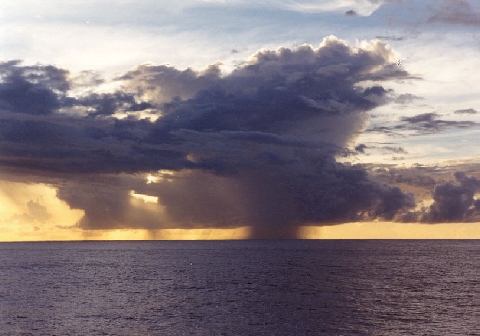
A rain shaft over the Indian Ocean, somewhere near the InterTropical Convergence Zone in the spring of 1998.

A rain shaft over the Indian Ocean, somewhere near the InterTropical Convergence Zone in the spring of 1998.
Why does anyone care how water vapor interacts with dust?
The clouds you see in the picture are the best example I could give. Why did that cloud rain
when and where it did? Is there ice in the cloud or is it only liquid water? Are the cirrus clouds
in the background remnants of a cumulonimbus like the one you see there, or were they formed through
some other mechanism? Would those clouds have the same properties if they formed in the northern Indian
Ocean, where there are 10 times more aerosol particles than in the southern Indian Ocean? Could a change
in the cloud properties on a regional or global scale affect Earth’s climate? Are cloud properties
changing because of anthropogenic activities?
Questions like those just posed are the driving force behind the kind of research that I do.
To answer many (if not all) of them requires comprehensive knowledge of cloud and aerosol microphysics,
which is the detailed study (sometimes down to the molecular level) of the interactions of aerosol
particles and cloud droplets with each other and with trace gases in the atmosphere.
I am currently investigating the mechanisms underlying heterogeneous nucleation of ice in the
atmosphere. Ice forms through two paths in the atmosphere. In the upper troposphere and stratosphere,
where temperatures can be colder than 40 degrees below zero, ice can form through homgeneous
nucleation of supercooled water droplets. However, in the lower troposphere, ice forms with the aid of
small bits of insoluble dust - hence the name heterogeneous nucleation.
One approach is to probe the arrangement of water molecules on suitable substrates (e.g. muscovite mica or long
chain alcohols) with Fourier Transform Infrared Spectroscopy. Since the hydrogen bonding network
between water molecules is particularly sensitive to perturbations from the influence of the substrate, I can
relate the spectroscopic signature to the water-substrate bond strength and to the degree of order in
the film of water molecules coating the substrate.
Some of the results, as presented in posters at various conferences over the past few years.
Heterogeneous nucleation of ice catalyzed by organic compounds
Ice nucleation by long chain alcohols: Infrared spectroscopy
Freezing of solutions catalyzed by long chain alcohols
Heterogeneous nucleation of ice from supercooled solutions by films of high molecular weight organic compounds
Heterogeneous ice nucleation during ozonolysis of organic thin films on aqueous solution droplets
The effect of ozonolysis on the freezing of water catalyzed by high molecular weight organic compounds
Heterogeneous nucleation of ice catalyzed by high molecular weight organic compounds,
before and after ozonolysis, using octadecene as a model
Organic compounds as deposition nuclei: compounds representative of biomass
burning emissions and oxidation products
Latent heat and the vapor pressure of water
Latent heat of freezing in glaciating clouds
Entropic aspects of supercooled droplet freezing
The vapor pressure of supercooled water measured using infrared spectroscopy
The temperature dependence of water's latent heat of freezing
Contact Nucleation
An instrument designed to measure ice nucleation in the contact mode